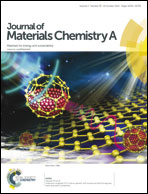Polyaromatic-hydrocarbon-based carbon copper composites for the suppression of electromagnetic pollution†
Abstract
A facile method of developing carbon–copper (C–Cu) nanocomposites by coating nanocrystalline Cu on heat-treated polyaromatic hydrocarbons (HTPAHs) has been reported. These synthesized nanocomposites have been extensively characterized by X-ray diffraction, Fourier transform infrared spectroscopy (FTIR), a scanning electron microscope (SEM), and transmission electron microscopy (TEM). The synthesized HTPAHs-based C–Cu nanocomposites exhibit improved mechanical and electrical properties, which could be tailored by varying the Cu nanoparticle loading. The highest electromagnetic interference shielding effectiveness (EMI SE) due to absorption and reflection at 12.4 GHz is 46.1 dB and 12.5 dB, respectively, for a 2 mm thick sample resulting in a total shielding effectiveness of 58.7 dB. This observed shielding effectiveness in these C–Cu nanocomposites is far above the threshold shielding effectiveness required for techno-commercial applications, especially in the Ku band of RF.


 Please wait while we load your content...
Please wait while we load your content...